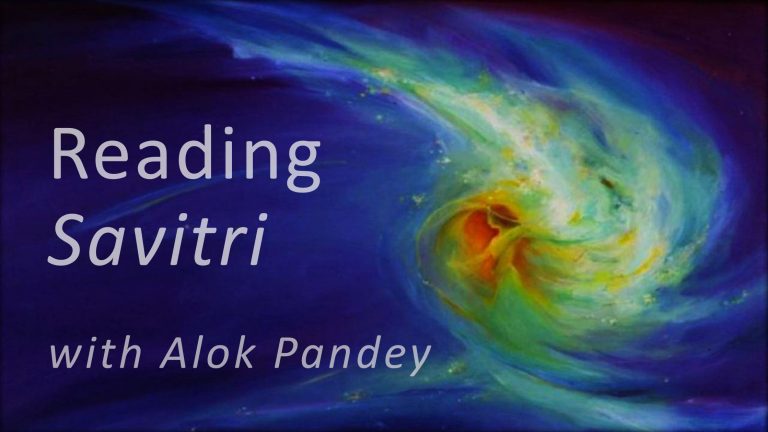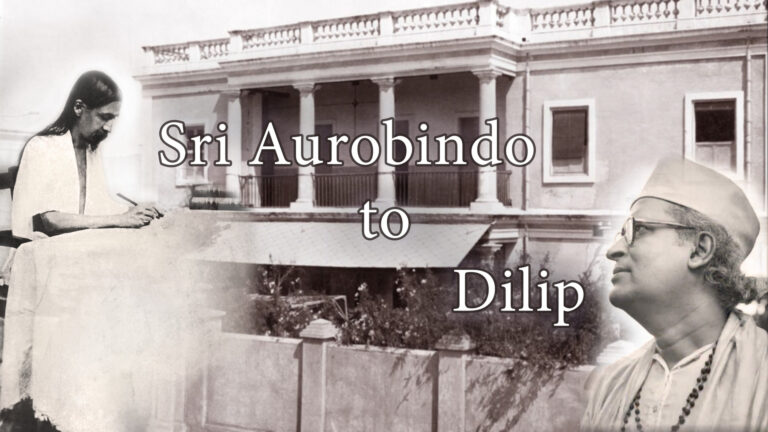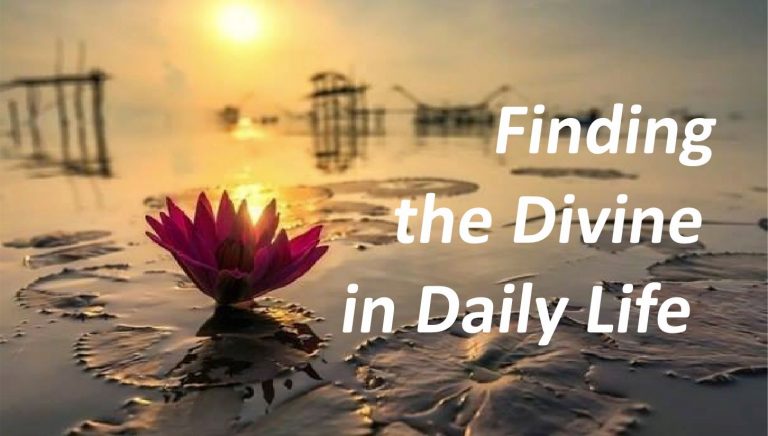An audio recording and a transcript of a talk, followed by a recitation of selections from the Savitri (Book One Canto 4)

“The Test of Truth”
THE test of Truth is its impossibility. I believe because it is impossible; Credo quia impossibile. That is Saint Augustine.
There is a grain, why a grain, quite a lump of truth in this well-known saying of a great seeker of Truth. Truth shall prevail. Is this true? Can it be true? It is impossible. Therefore it must be true. God exists: is it an impossibility? Therefore God does exist. Shall we ever come out of the present darkness? Impossible! We shall, therefore, come out, surely.
The possible, to our senses, is what is happening now: the present fact is the truth and what is in absolute agreement with the present is the possible or the probable truth. Anything going against or not consonant with the actual is a doubtful or even a negative quantity, but in fact at every moment everywhere there are upsettings of the apparently sure present: unnatural things do happen more often than not. But we do not pay or do not want to pay as much attention to these.
Who believed that India would be free and Britain go out lock, stock and barrel? Who believe that the Czardom would disappear for ever? And the Hohenzollerns and the Hapsburgs, where are they now? And the great Hitler? Even a few years ago who would have believed that man would walk on the moon? And can you believe now that matter can exist and does exist as anti-matter? Not in vain has the mad, bad and sad poet sung: Mais ou sont done les neiges d’antan? French poet Villon: Where, where are the snows of yesteryear?
The physical mind has to be taught, it must learn its lesson, that at every step something new, something unforeseen unpredicted and unpredictable is waiting in front to confound it. And it must gain the perception, the discrimination to recognise it, never to say, “Oh, it is natural, inevitable what is happening, there is nothing to wonder and dismiss the novelty of the thing as an illusion.”
The spiritual realities are at your door: they are neither non-existent nor too distant. Freedom, Peace, Calm, Happiness, Delight, Joy, Health are all there as self-existent realities. You have only to turn – or tilt as the Mother says – your consciousness a little and you are in the very midst of the thing. Doubt, hesitation merely casts a veil and blurs or blocks the view. God, Soul, Immortality, even these are equally available to the human consciousness in the same way. These are existences of daily use, so to say, of “common neighbourhood,” in the words of the poet – home truth.
A faith, necessarily a blind faith in these impossibles is its own authenticity, for it brings you immediately in direct contact with those apparently unseen, intangible realities. It gives you automatically a sense of certainty, a radiant clarity in the consciousness, that no other approach to Truth or Reality can give you. You feel, you know it is the truth, there is no shadow of any questioning anywhere, it is self-luminous. “Is it not self-hypnotism?” a scoffer might allege. Self-hypnot¬ism is a name: it is the power of consciousness to concentrate itself to such a degree that it can be changed into anything, even into its opposite. Self-absorbed consciousness in one form, at one extreme is the inconscient, at the other extreme it is the supra conscient Brahman. Consciousness is the power of being and it can give any form or name to the being. One becomes whatever one’s consciousness wants to become.
The ultimate verities are there indeed existing in themselves, and the mind’s attempt to question them, discuss them, judge them, doubt them, deny them is ludicrous. Even the mind’s attempt to affirm them, assert them or seize them is equally vain and ludicrous. The Upanishadic seer declares clearly and unequivocally: the word with all its effort cannot seize it, the mind cannot reach there, it turns back hopelessly. Therefore the seeker of the Truth is always advised from the very beginning and throughout to keep his mind quiet, vacate it, instil there the simple faith, to wait and let the thing come of itself. These realities are not acquisitions or possessions or even achievements, they are living entities, personalities. At the right time they come to you, they enter into you and possess you. You do not reach out and possess them. Even so, it was said of Nachiketas that faith entered into him, and therefore he could meet Death and become his friend and confidant. The Upanishad finally says: it is when the Truth discloses its own body to the seeker, then only can the seeker see the Truth in its truth.
Mind’s conceptions of the ultimate realities are very far from the actual truth. The mind has a conception of freedom or delight or even of consciousness; it has a conception of God and immortality, of infinity and eternity. But they are all its own creations, more or less. The highest summits of the mind may get a glimpse or a reflection of those supernals, but even as such they come only as an echo, an image, a faint replica of the actual thing. Freedom as it is in the Divine or with the Divine, Delight or Consciousness, as they are of the Divine have an altogether different quality, a different mode of vibration from that which is available to mind on its lower levels. What the mind receives is a re-formation, more often a deformation of the original as you go farther down the scale. Only if the mind itself is changed in its substance, regains a translucent passivity, then only can it see and see something of the secret glory of the higher realities.
“Body Energy”
THE Mother spoke once of the body being like a fortress, a strong shelter protecting you against enemy-attacks, the forces that are around roaming in the open spaces, the forces of physical and even moral disruption. The ancients used to refer to the body as a walled city the gates of which are to be carefully guarded. It is also compared to a temple, a firm structure wherein God is to dwell, which is to be kept always clean, trim and tidy. The body itself was worshipped as a holy thing almost as a Divinity by certain schools of spiritual discipline.
These are, so to say various dimensions of the body; one more, somewhat of a different category, may be added. The body is a battery, an accumulation of energy, of energy and consciousness, of energy-consciousness. We are all familiar with the modern concept of the material particle being concentrated energy: it is tremendously concentrated and that is why it looks as though dead solidity. In reality its stilled high potency harbours almost an immeasurable force of creation and destruction.
The release of energy, material energy, in matter, is the business of Science and the scientist; the release of consciousness, the energy of consciousness in matter is the business of yoga and the yogi. The tantrik discipline was in a large way occupied with this mystery. It found and developed -its own method and process and its success in its own field is also well recognised.
The body-content thus is essentially consciousness consolidated, crystallised. The problem then is how to release it. The first thing is that you must be conscious, you, that is to say, your body must be conscious, must be aware always of what it is doing: living, moving, acting; the body must be doing all that consciously, almost voluntarily: there shall be no involuntary movements. Each physical gesture must know itself by feeling itself in the act. It is not that the mind should know, the mind can have only a memory, but that the limb itself has to pursue its function knowingly, in full awareness. At the beginning there is inevitably a mixture of mental knowing but that is to be cleaned out and over passed One is conscious, can be conscious only through consciousness; consciousness is born through consciousness. It manifests, it grows through incubation, through self-centration. Energy energises itself, as the Upanishad says, tapas taptva. Energy is consciousness in movement and in moving it expresses itself, embodies itself. A muscle, for example, when moving, awakes to its own activity, the awakening is not confined to itself, but it extends gradually, extends to all its constituent cells and even to contiguous cells. The process in this way permeates the whole body and the entire material content of the body is filled with consciousness and with its radiant energy.
There is however a basic preliminary necessity, a preparatory condition: the first essential condition under which the body can be conscious of itself is its freedom, its absolute freedom. The body must be liberated wholly and entirely, it must feel its perfect freedom. As at present it is a slave: it never knows its own will, it is always under the orders of either the vital or the mind or both. Under the control of this dual masters – a cruel diarchy – the body has lost all its independent movements. The activities, almost all, of the present body are not really its own, they are expressions of an imposed will. In order to have and to be aware of its own the body must be freed from its alien imposition and as soon as it gains its freedom, it will know itself, learn itself, learn its own movements. It will gradually shred off all the wrong and distorted movements which form its present habits. We shall find that in itself the body is a sane entity and it is not in need of many things that have been suggested to it and instilled into it by forces that are outside it, almost foreign to it, the mental and the vital forces. The liberation will bring to it automatically the awareness of its own self, it will become, that is to say, conscious of itself and this consciousness will bring with it a pure and fresh energy which is that of its true self. As in the case of a subject nation the very fact of liberation brings to it the energy of self-consciousness and an exhilarating delight in the expression of the newfound selfhood, even as also in the case of the individual human being when he is freed from serfdom and slavery and bondages, he attains, realises the dignity of self-consciousness and self-power, even so the material body too becomes illumined with its freedom and rejoices in its power and energy to express its own truth. The first effect of freedom after a long subjugation is likely to be a spell of erraticism, but that is sure to die away if there is a corrective central will.
The body-movements in the animal are more authentic and truthful for they are not subsidised and suborned by the vital and mental injunctions, and they are more ordered and controlled, not subject to idiosyncrasies that sway the human character. They are more free and more natural: the same essential freedom and authenticity and purity shall belong to the body natural of the highest mode of being and consciousness.
However, in this age, at the present time the human body is inevitably moving towards such a consummation – towards freedom and buoyancy and radiancy, a new valency, a new self-law. The individual efforts are more than supplemented by a Grace that is at work in a supreme effective manner: for this is the hour of God – “when even a little effort produces great results and changes destiny.”



